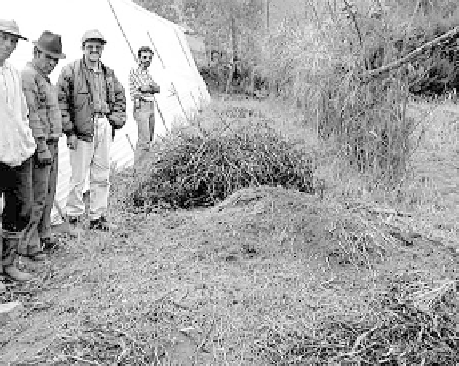Agriculture Reference
In-Depth Information
wheat, the next to clover, and so on Nearly all rotations include a legume crop. A
legume is a type of plant that forms a symbiotic relationship with bacteria (Rhizobium
spp.) that fix nitrogen from the air into a form usable by plants. A leguminous crop such
as red clover or soybean will produce forage or grain and leave 100 to 150 kg N/ha in
the soil after harvest.
Compost is another source of nitrogen as a fertilizer. In tropical climates compost-
ing is a rapid process, completing the cycle from raw plant material to finished compost
in 6 to 8 weeks. It is enhanced by the use of earthworms. In cooler climates, like that of
the Andes in Ecuador (Fig. 10.17), composting may last from 3 to 5 months. An advan-
tage of compost is that the nutrients are less concentrated and there is less danger of
damaging the crop. It also supplies organic matter that helps build up the soil and
keep it from eroding. Most importantly for the low income farmer, no cash is needed
to buy it.
A disadvantage of compost is that it has a relatively low nutrient content. If we
take a typical municipal compost (made from yard clippings, leaves, sewage, etc.),
we can expect to find about 1.5 percent nitrogen, 1.5 percent phosphate, and 1
percent potassium. Let's make the same calculations we made for the compound
chemical fertilizer. To replace the 125 kg of nitrogen per hectare that our maize crop
will remove, we will need to apply 8330 kg of compost on each hectare. Unfortunately,
this will give twice as much phosphorus as the maize crop needs, and we risk contami-
nating groundwater with the excess phosphorus. The other disadvantage will be to
transport 83 tons of compost and spread it on our 10 ha field. This assumes we can
afford to purchase 83 tons of good-quality compost. This is one of the reasons most
commercial farmers use chemical fertilizers. The cost of transport and application
can become very expensive.
It is possible to reduce the amount of applied fertilizer and maintain, or improve,
the nutrient status of soil. As previously mentioned, leguminous crops fix nitrogen, and
Figure
10.17.
Compost pile for a greenhouse in Ecuador.









